Speaking of Batman and Bruce Campbell...
Chapter 7: I’m Bat-Shemp!
Excerpt from All You Need is a Chin: Confessions of a B-Movie Actor by Bruce Campbell
With the end of the short but glorious run of
Buck Rogers, it was back to B-Movies and Bat-Shemping for me.
Try to contain your excitement.
My contract with Disney ended right about the same time that Sam and Lisa’s marriage did. Is that irony? I forget. I’ll ask Alanis Morrissette. But anyway, I was back with Sam in time to Bat-Shemp during the post-production of
Batman 2. Or as the pedantic fanboys never tire of telling me,
Batman: Rise of the Dark Knight, as it’s formally known. He had all the same actors: Willem Dafoe returned as Bats. Kevin Kline was back as Harvey Dent, having had his face acid-bathed by Robin Williams’ Joker in the first film. Sean Young was back as love interest Silver St. Cloud, Ian Abercrombie back as Alfred Pennyworth, and Pat Hingle back as Commissioner Gordon. But now he had Brandon Lee as the smart but athletic Dick Grayson, who Alfred hires as Bruce Wayne’s personal assistant. Naturally, Dick discovers the Bat Cave and gets recruited as Batman’s new sidekick, which Sam named Night Wing, because, let’s face it, Robin was box office poison in 1991. It’d take a serious rehab through the
Teen Titans cartoon before any studio would dare bring the Boy Wonder back in America.
Not this at all…
Sam also brought in the seductive Uma Thurman as Cat Woman/Selena Kyle. Uma had just made a name for herself as Zenobia in
Conan the Conqueror. I’d tried to get Sam to take Jen Tilley, but no luck. Still, though, it’s hard to argue with Uma. She’s like an actual living Valkyrie! And boy did she bring Catwoman to life.
But you knew all that. What you may not have known is that Sam doubled-down on the themes of duality from the first film. You had Bruce Wayne’s day job leading the philanthropy with faithful Silver St. Cloud as his love, and Batman’s night job with the mysterious and seductive Catwoman as temptation. You had the ongoing Batman themes of vengeance vs. justice and all that, with Catty representing the former and Silver representing the latter.
And then you had the villains, who took this whole duality thing to new and literal levels. The new False Face gang, led by the mysterious Black Mask[1], is the initial threat, filling in the crime vacuum left by the defeat of the Clownz in the prior film. Of course, the Black Mask is really this Roman Sionis guy we keep meeting, whose Janus Cosmetics (geddit? Named for the two-faced Roman god?) just got bailed out by Bruce Wayne, but which cost Sionis his job as CEO, leading him to seek power through crime. He’s also batshit insane and his gang likes to cut the skin from people’s faces as a warning, which the T rating wouldn’t let us show happening, so we had to, like, hint at it. Even so, the moral guardians freaked out seeing as how WB was selling Batman toys and Happy Meals to kids[2].
As an aside, I lobbied hard to play Sionis, but the studio went with Nicolas Cage, which made production…interesting to say the least. Nic and I had some long talks about comic books, at least when I could get him out of character long enough to talk about anything.
And, needless to say, Sionis is just the tip of the crime iceberg as it were (Crimeberg? Sounds like the title of my next film, knowing my luck), because behind it all is none other than former mayor Harvey Dent, now the mysterious underworld figure known as Two Face, who we last saw getting said acid bath from the Joker in the prior film.
And yea, I just spoiled the whole plot of the movie. But why are you reading my book if you haven’t seen my films? You have no one to blame but yourself, pal.
But anyway, now that he was a Big Time Director, Sam had to think about that type of stuff with themes and the like. We never worried too much about themes and the like when we did
Evil Dead or
Friday the 13th 5. Or at least I didn’t. And even Sam, living high in his lofty Big Hollywood ivory tower, was getting nostalgic for the ol’ “Ham & Cheese”. He’d produced
The Dead Next Door (starring yours truly) and
Lunatics: A Love Story (starring Ted), and was debating getting into TV, but he was a “big studio guy” now and doing schlock, at least back in ’91, was cutting your own throat.
“Welcome, Hollywood A-Listers, to the place where anybody can
be, or even
receive, a
Real Hack! Ehehehehehee!!!” (Image source “thehollywoodreporter.com”)
But thankfully, HBO had developed a loophole:
Tales from the Crypt. It was strange. This little, R-rated, bloody TV anthology series was managing to attract big Hollywood names to act or direct. Arnold Schwarzenegger, Michael J. Fox, Tom Hanks, or Whoopie Goldberg could all appear in the series and still get invited to sit up front at the Oscars. It was uncanny.
So, naturally, Sam approached them and directed “The Necronomicon”, a sort of pseudo-sequel to
The Evil Dead where Ash gets a package in the mail, and go figure it’s the Necronomicon. In his clumsy attempts to destroy the accursed thing he becomes possessed, as does everything in the lodge around him. There’s no real plot, just excuses for dumb Ash to be comedically abused by the spirits of the evil dead. He (by which, I mean I) ultimately cut off his/my own possessed hand in a shower of blood. He eventually gets sucked into a portal through time to a Medieval world. We used enough red dyed corn syrup to end hunger in Somalia. And we put in as much over the top twisted humor as we could. Even the deer trophy had a good laugh about it all.
“Come right in, deer. You’ll
die laughing…eheheheheheheheheeee!” (Image sources “whatculture.com” and “weminoredinfilm.com”)
So, the producers of Crypt loved it and it got good numbers and viewer buzz for its mix of slapstick comedy and horror. In fact, they wanted to do a movie. It was sort of this thing at the time where the producers wanted to do
Tales from the Crypt movie releases. Their first release would be
Death Becomes Her directed by Paul Verhoeven with Meryl Streep, Goldie Hahn, and Rick Moranis[3]. It became famous for its cutting-edge special effects and even won an Oscar for them. My now-wife Ida worked on the costuming with Cheryl Henson. Their costumes became legendary.
We were asked to do the second film. Given that Ash is flung into the past at the end of “The Necronomicon” that film became
Medieval Dead, which Sam wanted to be a salute to the old Ray Harryhausen films of the past. Sam was busy directing
Thinner and was on the hook to produce
Batman 3, so his brother Ted decided to take up the director’s chair. Ted had done some second unit stuff on
The Running Man and the Batman films, so he felt up to the task. I returned as Ash. We decided to take the bloody slapstick that we did with “The Necronomicon” and dial it to 11.
Basically this, but under the
Tales from the Crypt label
Tales from the Crypt: Medieval Dead, was just as batshit to work on as it is to watch. Tim Burton’s Skeleton Crew helped with not just the old school Harryhausen effects, but with the costuming, so I got to work with Ida again. I played not just Ash, but the Deadite-possessed “Bad Ash”. The action reached full blown Three Stooges levels of slapstick, if the Stooges had ever done a slasher. Sam and Ted squeezed in so many cheesy one-liners for the fans to endlessly quote that Schwarzenegger would have been embarrassed to say them all. If “The Necronomicon” could have fed Somalia with the red-dyed corn syrup, this film could have rotted the teeth of the entire population of China, including Hong Kong. We had fountains of it. That’s not an exaggeration. I’m talking Old Faithful here.
To make matters weirder, two of the extras made up as Deadites were caught “boning” on the set[4] between takes. Hollywood-style necrophilia? Everyone’s got their kink, I guess.
To this day fans ask me if
Medieval Dead would be considered a “Smart Slasher” or not. My official answer is “shut the hell up and get out of here!”
Anyway, between the surprising success of
Death Becomes Her and the honorable showing of
Medieval Dead, which more than doubled its piddling budget in returns,
Tales from the Crypt’s film franchise was cemented as a “thing” in the ‘90s. They did
Devil’s Knight (another supernatural medieval thing) and
Bloody Bordello (set in London, of course) next, followed eventually by Quentin Tarantino’s and Robert Rodriguez’s
From Dusk ‘till Dawn and Peter Jackson's
The Frighteners.
I like to think that I had a
hand in that success.
Get it? Hand? Because I cut off my…never mind. Even the Crypt Keeper wouldn’t touch that pun.
But Sam had bigger fish to fry. Dino de Laurentiis had approached him back on the set of
The Running Man to direct a version of Stephen King’s
Thinner, which he did in partnership with As You Wish after Dino had to sell off his own studio to ABC. It was released through Fantasia by his soon-to-be-ex-father-in-law Jim Henson in ‘91. He found actor Larry Drake to play the lead Billy Halleck, who through a combination of some personal weight loss and some creepy-convincing prosthetics from the Chiodo Brothers over at Skeleton Crew, managed to play the asshole lawyer who gets his comeuppance. I fought to play one of the judges. I got to play the carnie Biff Quigley.
This directed by Sam Raimi
In addition to directing
Thinner and pre-production on
Batman 3, Sam even imposed himself into the production of
Man of Steel, the new Warner Brothers Superman film, rebooting the stagnant franchise. He wrote up a treatment and later he and Ted cranked out a screenplay. Sam wanted to direct, but Warner wanted a more “sentimental” take for Sups, so they brought in Ron Howard.
Sam was disappointed. “What, do they really think I’d make Superman into some sort of black clad killer who breaks people’s necks or something? Who do they take me for?”
“Come on, Sam,” I told him, “You can’t hog the whole damned DC to yourself.”
“The last words to pass through my dying lips will be ‘Justice League,’” Sam replied with as much melodrama as he could squeeze in.
And yet with
Batman 3 in production and set for release in ’93, he had plenty to keep him busy.
As for me, well, if nothing else I could always look forward to Bat-Shemping.
Or the long-awaited debut of
Crimeberg.
[1] Two Face Fedora tip to
@Plateosaurus.
[2] In our timeline a similar “scandal” surrounded
Batman Returns, whose dark and violent themes and scenes clashed hard with the Happy Meals and toys they were pushing as “product integration.” The ensuing outrage helped fuel the campy, “toyetic” turn under Joel Schumacher.
[3] In our timeline when at the time top tier director Robert Zemeckis took an interest, they decided to drop the
Tales from the Crypt label. Butterflies sent Bruce Willis elsewhere in this timeline.
[4] According to our timeline’s
If Chins Could Kill, this happened on the set of
Army of Darkness. Too weird to butterfly!

 en.wikipedia.org
en.wikipedia.org

 en.wikipedia.org
en.wikipedia.org

 en.wikipedia.org
en.wikipedia.org

 en.wikipedia.org
en.wikipedia.org

 en.wikipedia.org
en.wikipedia.org














